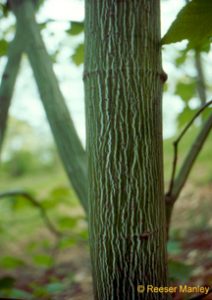Bulletin #2561, Native Trees and Shrubs for Maine Landscapes: Striped Maple or Moosewood (Acer pensylvanicum)
Developed by Marjorie Peronto, Associate Extension Professor, University of Maine Cooperative Extension; and Reeser C. Manley, Assistant Professor of Horticulture, University of Maine.
For information about UMaine Extension programs and resources, visit extension.umaine.edu.
Find more of our publications and books at extension.umaine.edu/publications/.
Go native!
This series of publications is the result of a five-year research project that evaluated the adaptability of a variety of native trees and shrubs to the stresses of urban and residential landscapes in Maine. Non-native invasive plants pose a serious threat to Maine’s biodiversity. Plants such as Japanese barberry, shrubby honeysuckle, and Asiatic bittersweet, originally introduced for their ornamental features, have escaped from our landscapes, colonizing natural areas and displacing native plants and animals. By landscaping with native plants, we can create vegetation corridors that link fragmented wild areas, providing food and shelter for the native wildlife that is an integral part of our ecosystem. Your landscape choices can have an impact on the environment that goes far beyond your property lines.
Description
Form: a short-trunked tree with ascending, arching branches and a broad, flat-topped to rounded crown
Size: 15 to 30 feet high, with a spread less than or equal to height
Ornamental characteristics:
- young trunk and branches are green with conspicuous, long, vertical white stripes
- six-inch-long pendulous clusters of pale yellow spring flowers
- large, bright green leaves turn vibrant yellow in the fall
Landscape Use
The key to success with striped maple lies in keeping its roots cool and moist. Use it in the woodland garden beneath the shade of taller deciduous trees, keeping company with mountain maple (Acer spicatum), pagoda dogwood (Cornus alternifolia), and witchhazel (Hamamelis virginiana), and underplanted with mapleleaf viburnum (Viburnum acerifolium) and hobblebush (V. alnifolium). In more open areas, mulch over the entire root system, at least three times the width of the canopy, and water during summer drought. Avoid using striped maple near “heat islands,” areas with extensive paving or building walls.
Another common name for A. pensylvanicum is “moosewood.” It is a favorite browse of both moose and deer and, in the wild, is often reduced by browsing to a multi-stemmed shrub. Be careful not to use this tree in gardens visited by moose or deer!
Culture
Hardiness: USDA zone 3b
Soil requirements: prefers moderately to well-drained, slightly acidic soils
Light requirements: shade or partial shade
Stress tolerances:
soil compaction—intolerant
pollution—unknown
deicing salts—intolerant
urban heat islands—intolerant
drought—intolerant
seasonal flooding—intolerant
Insect and disease problems: leaf scorch (from too much sun)
Wildlife Value
In the wild, the bark and young shoots of striped maple provide winter food for cottontail, deer, moose, and beaver. Of course, trees subjected to this browsing are transformed into multi-stemmed shrubs with little landscape value.
Maintenance

Irrigation: During the establishment period, defined as one year after planting for each inch of trunk diameter at planting time, water your trees regularly during the growing season. Give the root zone of each tree 1 inch of water per week; in general, a tree’s root zone extends twice as wide as its canopy. After the establishment period, provide supplemental irrigation during periods of severe drought.
Fertilization: Landscape trees and shrubs should not be fertilized unless a soil test indicates a need. Correct soil pH, if necessary, by amending the backfill soil. No nitrogen fertilizer should be added at planting or during the first growing season.
To learn more about native woody plants
Visit the Eastern Maine Native Plant Arboretum at University of Maine Cooperative Extension’s Penobscot County office, 307 Maine Avenue in Bangor. Established in 2004, the arboretum displays 24 different native tree and shrub species that can be used in managed landscapes.
Reviewed by Cathy Neal, Extension professor, University of New Hampshire Cooperative Extension.
Photos by Reeser C. Manley.
Illustration by Margery Read, Extension Master Gardener.
This series of publications and the associated research were made possible in part by the Maine Forest Service’s Project Canopy.
Information in this publication is provided purely for educational purposes. No responsibility is assumed for any problems associated with the use of products or services mentioned. No endorsement of products or companies is intended, nor is criticism of unnamed products or companies implied.
© 2008
Call 800.287.0274 (in Maine), or 207.581.3188, for information on publications and program offerings from University of Maine Cooperative Extension, or visit extension.umaine.edu.
In complying with the letter and spirit of applicable laws and pursuing its own goals of diversity, the University of Maine System does not discriminate on the grounds of race, color, religion, sex, sexual orientation, transgender status, gender, gender identity or expression, ethnicity, national origin, citizenship status, familial status, ancestry, age, disability physical or mental, genetic information, or veterans or military status in employment, education, and all other programs and activities. The University provides reasonable accommodations to qualified individuals with disabilities upon request. The following person has been designated to handle inquiries regarding non-discrimination policies: Director of Institutional Equity and Title IX Services, 5713 Chadbourne Hall, Room 412, University of Maine, Orono, ME 04469-5713, 207.581.1226, TTY 711 (Maine Relay System).





